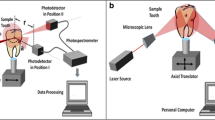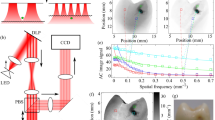Abstract
Objective
Early detection of caries is vital for demineralization reverse offering a less pain, as well as accurate and precise caries removal.
Materials and Methods
In this study, the difference in optical properties of normal tissue and human caries lesion has been used for early diagnosis, using laser induced fluorescence spectroscopy. The human tooth sample was illuminated with visible band sources (488, 514 and 633 nm) with power 5 mW. The reflected and emitted light of tested sample was collected using hyperspectral camera in an attempt to generate multispectral images (cubic image). The variation of reflected and emitted power as function in wavelength was employed to generate characteristic spectrum of each tooth tissue. Human teeth caries tissue lesion releases its excess power by emitting fluorescence light producing chemical footprint signature; this signature is dependent on the elemental composition of tooth elements and caries state.
Results
This non-invasive, non-contact and non-ionizing imaging system with associated novel pattern recognition algorithm was employed to diagnose and classify dental (enamel and dentin), caries, and white spot lesion. It was reported that the perceived fluorescence emission is function of the illuminating wavelength. While enamel and dentin caries were distinguished and characterized at 633 nm illuminating wavelength; white spot lesion cannot be detected. The enamel caries, dentin caries, and white spot lesion were contoured and recognized at 488 nm and 514 nm wavelengths. Therefore full recognition was achieved through generated cubic image after sample irradiation at 488 nm and 514 nm.
Conclusions
This non-invasive, non-contact, and non-ionizing imaging technique with customized image processing algorithm offered high sensitivity, high resolution, and early caries detection with optimum performance at 514 nm.


















Similar content being viewed by others
References
Horbal A, Reardon RJM, Liuti T, Dixon PM (2017) Evaluation of ex vivo restoration of carious equine maxillary cheek teeth infundibulae following debridement with dental drills and Hedstrom files. Vet J 230:30–35
Silva PFD, Oliveira LRS, Braga SSL, Signori C, Armstrong SR, Soares CJ, Cenci MS, Faria-e-Silva AL (2018) Effect of selective carious tissue removal on biomechanical behavior of class II bulk-fill dental composite restorations. Dent Mater 34:1289–1298
Silva P et al (2014) Dentin reactions to caries are misinterpreted by histological ?Gold standards? [version 1; referees: 1 approved, 2 approved with reservations. F1000Research 3(3):13
de Araújo Neto EV et al (2018) Antimicrobial photodynamic therapy associated with partial removal of carious tissue in a patient with amyotrophic lateral sclerosis. Photodiagn Photodyn Ther
Ortega-Verdugo P, Warren JJ, Kolker JL, Carter KD, Guzmán-Armstrong S, Gomez MR (2018) Retrospective analysis of factors associated with the success of stepwise excavation procedure in deep carious lesions. J Am Dent Assoc 149(6):442–450
Taha NA, Abdulkhader SZ (2018) Full pulpotomy with biodentine in symptomatic young permanent teeth with carious exposure. J Endod 44(6):932–937
da Silva TSP, et al. (2018) Do HEMA-free adhesive systems have better clinical performance than HEMA-containing ones in non-carious cervical lesions? A systematic review and meta-analysis. J Dent
Sabrah AH, Turssi CP, Lippert F, Eckert GJ, Kelly AB, Hara AT (2018) 3D-image analysis of the impact of toothpaste abrasivity on the progression of simulated non-carious cervical lesions. J Dent 73:14–18
Schneider H, Park KJ, Rueger C, Ziebolz D, Krause F, Haak R (2017) Imaging resin infiltration into non-cavitated carious lesions by optical coherence tomography. J Dent 60:94–98
Elhennawy K, Askar H, Jost-Brinkmann PG, Reda S, al-Abdi A, Paris S, Schwendicke F (2018) In vitro performance of the DIAGNOcam for detecting proximal carious lesions adjacent to composite restorations. J Dent 72:39–43
Kleter GA (1998) Discoloration of dental carious lesions (a review). Arch Oral Biol 43(8):629–632
Makhija SK, Shugars DA, Gilbert GH, Litaker MS, Bader JD, Schaffer R, Gordan VV, Rindal DB, Pihlstrom DJ, Mungia R, Meyerowitz C, National Dental Practice-Based Research Network Collaborative Group (2017) Surface characteristics and lesion depth and activity of suspicious occlusal carious lesions: findings from the National Dental Practice-Based Research Network. J Am Dent Assoc 148(12):922–929
Merametdjian L et al. (2018) Oro-dental phenotype in patients with RUNX2 duplication. European Journal of Medical Genetics
Döring S, Arzi B, Winer JN, Kass PH, Verstraete FJM (2018) Dental and temporomandibular joint pathology of the grey wolf (Canis lupus). J Comp Pathol 160:56–70
Hayashi M, Yamada T, Lynch CD, Wilson NHF (2018) Teaching of posterior composites in dental schools in Japan – 30 years and beyond. J Dent 76:19–23
Khan A, Qureshi B, Qureshi A, Imtiaz Y, Qadeer S (2018) Correlation of salivary characteristics with high risk of dental caries; a clinical investigation. Future Dental Journal 4(1):72–75
Levi LE, Lalla RV (2018) Dental treatment planning for the patient with oral cancer. Dent Clin N Am 62(1):121–130
Lewis M (2018) Chapter 4 - Dental disease, defects, and variations in dental morphology. In: Lewis M (ed) Paleopathology of Children. Academic Press, San Diego, pp 67–89
El-Sharkawy YH (2014) Image processing with the radial Hilbert transform of photo-thermal imaging for carious detection. in SPIE BiOS: SPIE
Ghassemian H (2016) A review of remote sensing image fusion methods. Information Fusion 32:75–89
Serranti S, Palmieri R, Bonifazi G, Cózar A (2018) Characterization of microplastic litter from oceans by an innovative approach based on hyperspectral imaging. Waste Manag 76:117–125
Suktanarak S, Teerachaichayut S (2017) Non-destructive quality assessment of hens’ eggs using hyperspectral images. J Food Eng 215:97–103
El-Sharkawy YH, Elbasuney S (2018) Design and implementation of novel hyperspectral imaging for dental carious early detection using laser induced fluorescence. Photodiagn Photodyn Ther 24:166–178
Elbasuney S, El-Sharkawy YH (2018) Instant identification of explosive material: laser induced photoacoustic spectroscopy versus Fourier transform infrared. TrAC Trends Anal Chem 108:269–277
El-Sharkawy YH, Elbasuney S (2018) Real time recognition of explosophorous group and explosive material using laser induced photoacoustic spectroscopy associated with novel algorithm for time and frequency domain analysis. Spectrochim Acta A Mol Biomol Spectrosc 204:25–32
El-Sharkawy Y (2015) Design and implementation of noninvasive laser imaging system for human teeth carious detection and removal. Journal of Dental Lasers 9(2):80–88
Sommer L (ed) (1989) Analytical absorption spectophotometry in the visible and ultraviolet: the principles. Elsevier, Amesterdam
Fang L, Zhuo H, Li S (2018) Super-resolution of hyperspectral image via superpixel-based sparse representation. Neurocomputing 273:171–177
Che W, Sun L, Zhang Q, Tan W, Ye D, Zhang D, Liu Y (2018) Pixel based bruise region extraction of apple using Vis-NIR hyperspectral imaging. Comput Electron Agric 146:12–21
Algarni AA, Ungar PS, Lippert F, Martínez-Mier EA, Eckert GJ, González-Cabezas C, Hara AT (2018) Trend-analysis of dental hard-tissue conditions as function of tooth age. J Dent 74:107–112
Yadav K, Prakash S (2016) Dental caries: a review. Asian Journal of Biomedical and Pharmaceutical Sciences 6(53):7
Ortega-Ojeda FE, Torre-Roldán M, García-Ruiz C (2017) Short wave infrared chemical imaging as future tool for analysing gunshot residues patterns in targets. Talanta 167:227–235
Thomas J, Ando J (eds) (1996) Ultraviolet and visible spectroscopy. John Wiley & Sons, Chichester
Funding
Military Technical College, Cairo, Egypt, is acknowledged for funding the research project “New prospective for dental tooth caries detection”.
Author information
Authors and Affiliations
Corresponding author
Ethics declarations
Conflict of interest
The authors declare that they have no conflict of interest.
Ethical approval
This article does not contain any studies with human participants or animals performed by any of the authors.
Informed consent
Informed consent was obtained from all individual participants included in the study.
Additional information
Publisher’s note
Springer Nature remains neutral with regard to jurisdictional claims in published maps and institutional affiliations.
This work has been conducted at the Nanotechnology Research Center in collaboration with the Department of Biomedical Engineering.
Rights and permissions
About this article
Cite this article
El-Sharkawy, Y.H., Elbasuney, S. Hyperspectral imaging system associated with novel subtracting image processing algorithm for dental caries early detection. Laser Dent Sci 3, 155–167 (2019). https://doi.org/10.1007/s41547-019-00068-5
Received:
Accepted:
Published:
Issue Date:
DOI: https://doi.org/10.1007/s41547-019-00068-5




